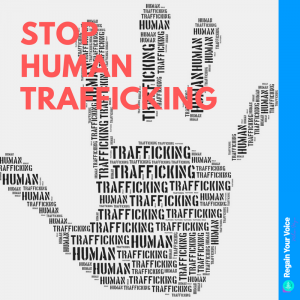*Content Warning*
What We Don’t Talk About When We Talk About Human Trafficking
By Tara Cattell
“Human trafficking involves the use of force, fraud, or coercion to obtain some type of labor or commercial sex act. Every year, millions of men, women, and children are trafficked worldwide – including right here in the United States. It can happen in any community and victims can be any age, race, gender, or nationality. Traffickers might use violence, manipulation, or false promises of well-paying jobs or romantic relationships to lure victims into trafficking situations.” (US Dept. of Homeland Security)
 It’s January – National Slavery and Human Trafficking Prevention Month. When you think about human trafficking, what do you imagine? I would guess that most people see the image that tv and films often portray, that of a woman or girl being kidnapped or abducted by an unknown man or group of men and forced into a life of exploitation. Maybe you think of Liam Neeson in Taken. I haven’t actually seen it, but I know that it isn’t a realistic representation of the commercial sexual exploitation industry. I want to challenge some of the commonly held beliefs about human trafficking and commercial sexual exploitation (CSE) in particular.
It’s January – National Slavery and Human Trafficking Prevention Month. When you think about human trafficking, what do you imagine? I would guess that most people see the image that tv and films often portray, that of a woman or girl being kidnapped or abducted by an unknown man or group of men and forced into a life of exploitation. Maybe you think of Liam Neeson in Taken. I haven’t actually seen it, but I know that it isn’t a realistic representation of the commercial sexual exploitation industry. I want to challenge some of the commonly held beliefs about human trafficking and commercial sexual exploitation (CSE) in particular.
Men and boys can be trafficked (and not just for labor).
Men and boys are often absent from the conversations surrounding commercial sexual exploitation in public policy, research, academics, social services, and the justice system. One thought is that men are perceived as having more agency over their bodies and their choices, therefore they are not really victims or they don’t need services and support. Men and boys are also less likely to report sexual abuse, often due to the expectations and pressures put on men and boys in our society. But we have to acknowledge the trauma that men and boys suffer as a result of being exploited.
According to the US Dept. of State’s Office to Monitor and Combat Trafficking in Persons:
“Too often, men and boys go unidentified and remain in perilous situations, deprived of their freedom. When they do escape their trafficking situations, they are likely to be neglected by governments and service providers whose programs were established to shelter and assist women and girls. Instead of being treated as exploited individuals, they are at greater risk of being penalized or fined for offenses, such as crossing a border illegally, or of facing charges and imprisonment for crimes committed as a result of being trafficked.”
Awareness surrounding the CSE of men and boys is important so that male survivors of trafficking get access to culturally appropriate and comprehensive assistance to meet their needs. This can include housing, medical care, mental health treatment, legal support, and employment assistance, among other things. As advocates for healing and justice, we must support the men and boys who are so often left out of the conversation.
Adult women can be traffickers and many are also victims.
Data is limited when it comes to the statistics of human trafficking. We only know what has been reported by victims themselves, social services, and by law enforcement agencies. So, it can be difficult to get a clear picture of what CSE really looks like and who is involved behind the scenes. But one thing we know for sure is that women are involved in the trafficking framework. Studies show women traffickers are particularly active in the recruitment phase of human trafficking. According to a 2015 study by the United Nations Office on Drugs and Crime, it’s estimated that globally, around 62% of suspected traffickers are men, while 38% are women.*
Kristen Houser, former Chief Public Affairs Officer for the National Sexual Violence Resource Center’s Pennsylvania Coalition Against Rape, told Insider that one of the most common pathways for a woman to become involved in the inner workings of a sex-trafficking operation is to have been a victim herself, often from a young age. Although many are themselves victims who are forced to recruit other victims, women play a significant role in trafficking operations. It’s important to understand that trafficking victims can be used against each other to enforce power dynamics, often a hierarchy system. Traffickers are at the top of that hierarchy. Below them are the women they have chosen to be recruiters. This position is often used as a ploy to trap victims. The woman may present herself as having a desired lifestyle which can be attained through recruitment. While we can all recognize the heinous act of recruiting trafficking victims, we must also note that many of the women in these recruitment rolls are victims who are forced or coerced into recruiting.
* Often, when statistics on human trafficking are gathered the only two genders included are male and female. This is another cause of incomprehensive data on the subject.
Familial trafficking of children is not uncommon, just under reported.
When I asked you at the beginning of this blog to think about what human trafficking looks like, did you think about familial trafficking? According to The Counter-Trafficking Data Collaborative, almost half of identified cases of child trafficking begin with some family member involvement. In cases of commercial sexual exploitation of children (CSEC), it is often a direct relative that is involved.
Although this may sound shocking, children are more likely to be trafficked by someone they know. This same principle applies to child sexual abuse in general; most often it is someone they know who is abusing them. This makes children less likely to speak up at the time of abuse and can cause compounded traumatic effects in the future. Cases of familial CSEC can go unnoticed because of the commonly held belief that people would not exploit their own family members, especially children, for their own gain.
There are many forms of CSEC, including child pornography and the sale of children for sexual abuse. Whenever a child is involved in commercial sex, it is exploitation. Children cannot consent to sex work. Another disturbing way that children are exploited by family members is though child marriage. In the United States, it is currently legal in 46 states (those not included are NJ, PA, DE, and MN) for children to marry adults. Most states have a minimum age of 18 for marriage but allow loopholes like parental consent that can leave children vulnerable. Parents willingly (or are coerced into) signing legal documents which essentially give their child away to an adult for sexual abuse and exploitation. Tens of thousands of children are legally exchanged in this way every year in the US. Cases like this will continue to fly under the radar as long as child marriage remains legal in the US.
In cases of commercial sexual exploitation of an adult, it is often an intimate partner involved in the exploitation. Intimate partner abuse is one of the most commonly unnoticed forms of sexual violence against adults. Fortunately, more people are becoming aware of this form of domestic violence and the reasons why it is so hard for victims to leave their abusers. There are so many forms of manipulation and coercion used in this form of abuse, like financial dependency, trauma bonding (think: Stockholm Syndrome), gaslighting, and physical abuse/threats. Some perpetrators, including traffickers, even use forced drug dependency as a way to control their victims.
We need to start talking about these issues more. We need people to see the side of human trafficking that they would otherwise not notice. Knowing what to look for can help victims/survivors get the support they need and hold perpetrators accountable.
*********************************
FOR MORE INFORMATION AND TO FIND SUPPORT:
National Human Trafficking Hotline: 1 (888) 373-7888
SMS: 233733 (Text “HELP” or “INFO”)
Hours: 24 hours, 7 days a week
Languages: English, Spanish and 200 more languages
Website: humantraffickinghotline.org
Also:





